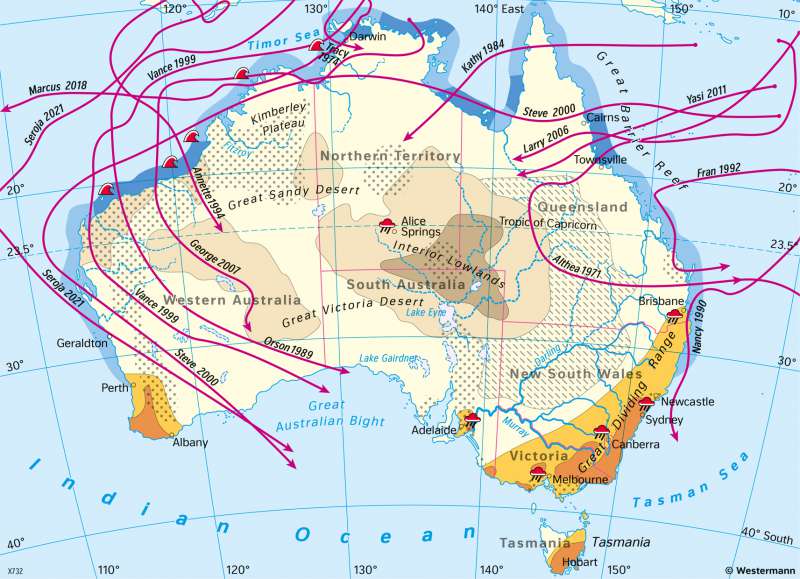Australia - Natural risks and hazards
Hazardous environment
978-3-14-100890-6 | Page 166 | Ill. 1

Overview
Australia is vulnerable. Due to its big area and its location at the edge of the tropics, the continent is exposed to a high number of climatic as well as to minor geotectonic hazards.
Climatic natural hazards
Cyclones are common in in northern Australia. They typically reach the continent between the months of November and April. Originating in Southeast Asia or the Western Pacific, these storms often track west or south along the coasts of Australia. A cyclone hazard exists in all coastal regions north of 30° S, and the storms can even reach into the southern basins of Western Australia. A recent example is Cyclone Seroja, which reached the west coast in April 2021 and caused extensive damage.
Other climatic natural events are heavy rainfalls which can lead to widespread flooding. Particularly vulnerable regions are the rivers of Northern Australia and the cities of New South Wales and Queensland, especially when the rainfalls are in connection with cyclones. In the Murray-Darling river basin, seldom but heavy floods can occur too.
Bushfires occur annually in the summer months in southwestern and southeastern Australia and are part of the natural ecosystem. They are often driven by the El Nino phenomenon, which can lead to a sharp drop in rainfall. However, the patterns become more irregular: for example, the devastating bushfires of the 2019/2020 fire season started as early as June 2019, and there was no influence of El Nino recorded. The fires spread to a total area of 170,000 km² by March 2020.
Even without these dramatic weather events, Australia is at high risk as the continent exists on the brink of drought. Drought-prone regions are located in the central desert areas south of Alice Springs and in the continental part of Western Australia. However, drought events in farming areas have much more severe consequences.
The threat of climatic natural hazards will increase due to climate change. Until the end of the 21st century, IPCC models predict a temperature rise of 2 - 5 K in the north and centre as well as a precipitation decline of 10 - 30 % in the south and southwest of Australia. The changes will make the already dry continent even more prone to droughts. At the same time, rainfalls become less frequent but more intense, leading to an increased flooding hazard. With an expected rise of the surface ocean temperature of 2 - 4 K around the Indonesian archipelago, stronger cyclones will likely occur.
Geotectonic natural hazards
Many regions of Australia are affected by geo-tectonic events, although the hazards and damages are small in relation to those of the climatic events.
Minor earthquakes can occur in many parts of Australia, particularly in the northwest and west, the central outback and in the regions around Adelaide, Sydney and Melbourne. The Earthquakes are caused by tectonic fractures and fault lines. In the regions in north-western Australia, the Earthquake hazard is accompanied with tsunami hazards. With generally low run-ups (i.e. elevation above sea level), they seldom pose a risk to coastal communities.
Australia's earthquakes rarely reach high magnitudes and usually do not cause widespread damage. One exception is the Newcastle earthquake north of Sydney. On 28th December 1989, about 50,000 buildings were destroyed by the magnitude 5.6 event. The Earthquake claimed 13 lives.
Geotectonic natural hazards
Minor earthquakes can occur in many parts of Australia, particularly in the northwest and west, the central outback and in the regions around Adelaide, Sydney and Melbourne. The earthquakes are caused by tectonic fractures and fault lines. In the regions in north-western Australia, the earthquake hazard is accompanied with tsunami hazards. With generally low run-ups (i.e. elevation above sea level), they seldom pose a risk to coastal communities.
Australia's earthquakes rarely reach high magnitudes and usually do not cause widespread damage. One exception is the Newcastle earthquake north of Sydney. On 28th December 1989, about 50,000 buildings were destroyed by the magnitude 5.6 event. The earthquake claimed 13 lives.
Author:
Christoph Zwissler




